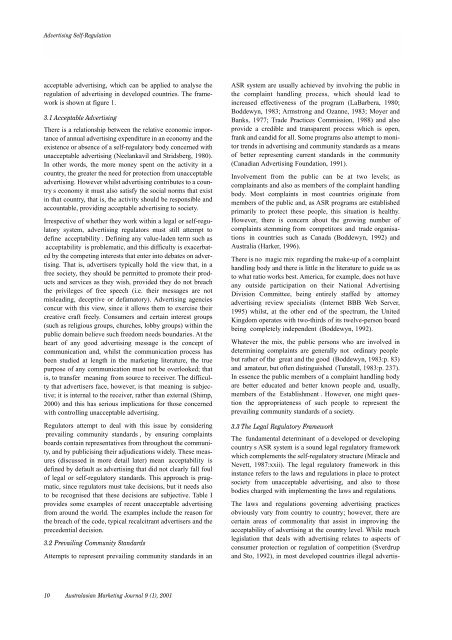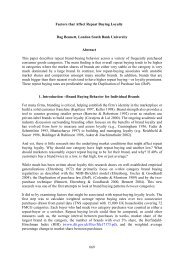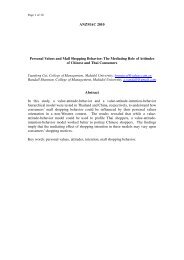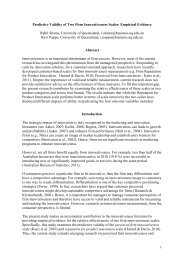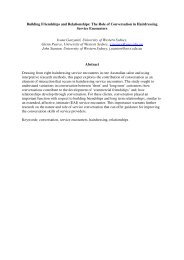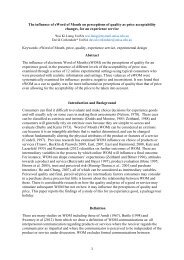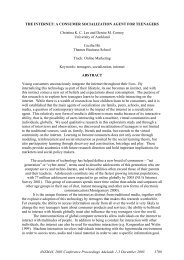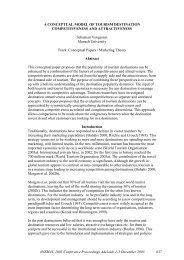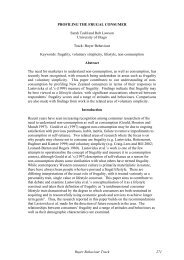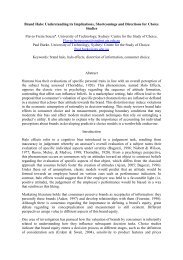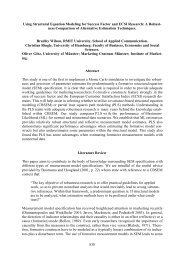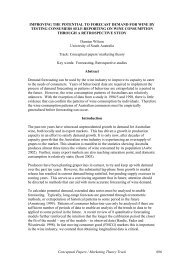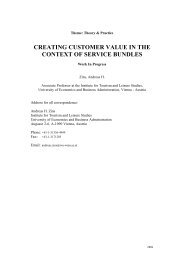amj Australasian Marketing Journal - ANZMAC
amj Australasian Marketing Journal - ANZMAC
amj Australasian Marketing Journal - ANZMAC
You also want an ePaper? Increase the reach of your titles
YUMPU automatically turns print PDFs into web optimized ePapers that Google loves.
Advertising Self-Regulation<br />
acceptable advertising, which can be applied to analyse the<br />
regulation of advertising in developed countries. The framework<br />
is shown at figure 1.<br />
3.1 Acceptable Advertising<br />
There is a relationship between the relative economic importance<br />
of annual advertising expenditure in an economy and the<br />
existence or absence of a self-regulatory body concerned with<br />
unacceptable advertising (Neelankavil and Stridsberg, 1980).<br />
In other words, the more money spent on the activity in a<br />
country, the greater the need for protection from unacceptable<br />
advertising. However whilst advertising contributes to a country<br />
s economy it must also satisfy the social norms that exist<br />
in that country, that is, the activity should be responsible and<br />
accountable, providing acceptable advertising to society.<br />
Irrespective of whether they work within a legal or self-regulatory<br />
system, advertising regulators must still attempt to<br />
define acceptability . Defining any value-laden term such as<br />
acceptability is problematic, and this difficulty is exacerbated<br />
by the competing interests that enter into debates on advertising.<br />
That is, advertisers typically hold the view that, in a<br />
free society, they should be permitted to promote their products<br />
and services as they wish, provided they do not breach<br />
the privileges of free speech (i.e. their messages are not<br />
misleading, deceptive or defamatory). Advertising agencies<br />
concur with this view, since it allows them to exercise their<br />
creative craft freely. Consumers and certain interest groups<br />
(such as religious groups, churches, lobby groups) within the<br />
public domain believe such freedom needs boundaries. At the<br />
heart of any good advertising message is the concept of<br />
communication and, whilst the communication process has<br />
been studied at length in the marketing literature, the true<br />
purpose of any communication must not be overlooked; that<br />
is, to transfer meaning from source to receiver. The difficulty<br />
that advertisers face, however, is that meaning is subjective;<br />
it is internal to the receiver, rather than external (Shimp,<br />
2000) and this has serious implications for those concerned<br />
with controlling unacceptable advertising.<br />
Regulators attempt to deal with this issue by considering<br />
prevailing community standards , by ensuring complaints<br />
boards contain representatives from throughout the community,<br />
and by publicising their adjudications widely. These measures<br />
(discussed in more detail later) mean acceptability is<br />
defined by default as advertising that did not clearly fall foul<br />
of legal or self-regulatory standards. This approach is pragmatic,<br />
since regulators must take decisions, but it needs also<br />
to be recognised that these decisions are subjective. Table I<br />
provides some examples of recent unacceptable advertising<br />
from around the world. The examples include the reason for<br />
the breach of the code, typical recalcitrant advertisers and the<br />
precedential decision.<br />
3.2 Prevailing Community Standards<br />
Attempts to represent prevailing community standards in an<br />
10 <strong>Australasian</strong> <strong>Marketing</strong> <strong>Journal</strong> 9 (1), 2001<br />
ASR system are usually achieved by involving the public in<br />
the complaint handling process, which should lead to<br />
increased effectiveness of the program (LaBarbera, 1980;<br />
Boddewyn, 1983; Armstrong and Ozanne, 1983; Moyer and<br />
Banks, 1977; Trade Practices Commission, 1988) and also<br />
provide a credible and transparent process which is open,<br />
frank and candid for all. Some programs also attempt to monitor<br />
trends in advertising and community standards as a means<br />
of better representing current standards in the community<br />
(Canadian Advertising Foundation, 1991).<br />
Involvement from the public can be at two levels; as<br />
complainants and also as members of the complaint handling<br />
body. Most complaints in most countries originate from<br />
members of the public and, as ASR programs are established<br />
primarily to protect these people, this situation is healthy.<br />
However, there is concern about the growing number of<br />
complaints stemming from competitors and trade organisations<br />
in countries such as Canada (Boddewyn, 1992) and<br />
Australia (Harker, 1996).<br />
There is no magic mix regarding the make-up of a complaint<br />
handling body and there is little in the literature to guide us as<br />
to what ratio works best. America, for example, does not have<br />
any outside participation on their National Advertising<br />
Division Committee, being entirely staffed by attorney<br />
advertising review specialists (Internet BBB Web Server,<br />
1995) whilst, at the other end of the spectrum, the United<br />
Kingdom operates with two-thirds of its twelve-person board<br />
being completely independent (Boddewyn, 1992).<br />
Whatever the mix, the public persons who are involved in<br />
determining complaints are generally not ordinary people<br />
but rather of the great and the good (Boddewyn, 1983:p. 83)<br />
and amateur, but often distinguished (Tunstall, 1983:p. 237).<br />
In essence the public members of a complaint handling body<br />
are better educated and better known people and, usually,<br />
members of the Establishment . However, one might question<br />
the appropriateness of such people to represent the<br />
prevailing community standards of a society.<br />
3.3 The Legal Regulatory Framework<br />
The fundamental determinant of a developed or developing<br />
country s ASR system is a sound legal regulatory framework<br />
which complements the self-regulatory structure (Miracle and<br />
Nevett, 1987:xxii). The legal regulatory framework in this<br />
instance refers to the laws and regulations in place to protect<br />
society from unacceptable advertising, and also to those<br />
bodies charged with implementing the laws and regulations.<br />
The laws and regulations governing advertising practices<br />
obviously vary from country to country; however, there are<br />
certain areas of commonality that assist in improving the<br />
acceptability of advertising at the country level. While much<br />
legislation that deals with advertising relates to aspects of<br />
consumer protection or regulation of competition (Sverdrup<br />
and Sto, 1992), in most developed countries illegal advertis-


